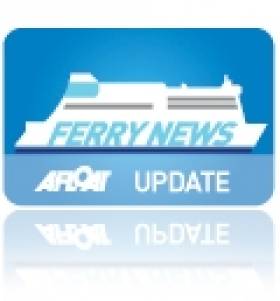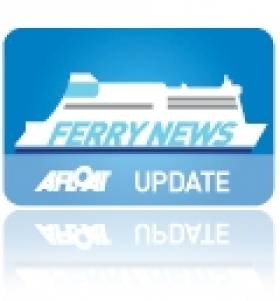Displaying items by tag: Isle of Man Steam Packet Company Ltd
‘Girl of My Heart’ to Make a Fleeting Port of Call
#MANX FERRY - This busy August Bank Holiday weekend sees the Isle of Man Steam Packet Co. Ltd's larger ferry Ben-My-Chree (Manx for 'Girl of my Heart') make an overnight round-trip sailing to Dublin Port, rather than the smaller fast-ferry craft Manannan, writes Jehan Ashmore.
Normally Ben-My-Chree, a conventional ro-pax ferry plies the Douglas-Heysham route, however with this evening's sailing taking 4hrs 45 minutes, she is scheduled to dock in Dublin Port just after midnight.
She is to berth at the same berth used frequently by Irish Ferries, however her turn-around is a mere 45 minutes before she returns to the island. Otherwise the Manannan, a 96m wave-piercing catamaran fast-ferry takes only 2hrs 55 minutes to cover the Irish route which is a seasonal-only service.
Instead Manannan is to operate this evenings Liverpool-Douglas sailing. She will stay overnight in the Manx capital so to take up tomorrow morning's crossing to Belfast, which is also run on a seasonal basis.
National Ferry Fortnight Launched
#FERRY FORTNIGHT – With today's St. Patrick's Day festivities, the national event also coincides with the launch of our nearest neighbour's National Ferry Fortnight (17th-30th March) campaign held in the UK, writes Jehan Ashmore.
Each year around 13m people travelled between the UK and Ireland while more than 10m people took to the skies.
The UK has an extensive ferry network of approximately 50 routes including those serving the islands. Of the 11 shipping operators that are members of the Passenger Shipping Association (PSA), five of them serve on routes to Ireland.
Those participating in the ferry campaign which operate on the Irish market are Brittany Ferries, Irish Ferries, Isle of Man Steam Packet Company, P&O and Stena Line.
To read more about all the ferry firms participating in the National Ferry Fortnight campaign click HERE.
Manx Seasonal Visitor to Dublin Port
Following this mornings Irish route sailing, she resumed on her regular Douglas-Heysham route and she also serves Douglas-Birkenhead (Liverpool) during the winter months.
During the summer Dublin-Douglas sailings are served by fast-ferry catamaran Manannan (1998/5,743grt). The 96m InCAT built in Hobart,Tasmania had also operated Douglas-Belfast high-season crossings. Her roster is now confined to a Douglas-Liverpool sailing schedule.
Ben-My-Chree (photo) is Manx for 'Girl of my heart' and her island owners commissioned the 12,504grt ro-pax from Dutch shipbuilders Van de Giessen-de Noord. The 125m ferry was launched in 1998 and she can accommodate 630 passengers,275 vehicles and 1,235 freight lane-metres.
This particular ro-pax design has also been built for Channel Islands operator Commodore Ferries with their Commodore Clipper and a Scandinavian ferry operator. In addition another Dutch shipbuilder, Merwede built a multi-support vessel (MRV) derived from the design of Ben-My-Chree for the Royal New Zealand Navy when they commissioned HMNZS Canterbury (L421). Click for similar port-side photo view to compare differences.
Incidentally the Manannan prior to entering service last year for the IOMSPCo. was for five years chartered initially to the United States Navy but transferred to the United States Army Forces. To read more click HERE.































































